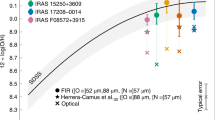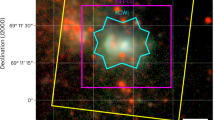Abstract
In typical astrophysical environments, the abundance of heavy elements ranges from 0.001 to 2 times the solar value. Lower abundances have been seen in selected stars in the Milky Way’s halo1,2,3 and in two quasar absorption systems at redshift z = 3 (ref. 4). These are widely interpreted as relics from the early Universe, when all gas possessed a primordial chemistry. Before now there have been no direct abundance measurements from the first billion years after the Big Bang, when the earliest stars began synthesizing elements. Here we report observations of hydrogen and heavy-element absorption in a spectrum of a quasar at z = 7.04, when the Universe was just 772 million years old (5.6 per cent of its present age). We detect a large column of neutral hydrogen but no corresponding metals (defined as elements heavier than helium), limiting the chemical abundance to less than 1/10,000 times the solar level if the gas is in a gravitationally bound proto-galaxy, or to less than 1/1,000 times the solar value if it is diffuse and unbound. If the absorption is truly intergalactic5,6, it would imply that the Universe was neither ionized by starlight nor chemically enriched in this neighbourhood at z ≈ 7. If it is gravitationally bound, the inferred abundance is too low to promote efficient cooling7,8, and the system would be a viable site to form the predicted but as yet unobserved massive population III stars.
This is a preview of subscription content, access via your institution
Access options
Subscribe to this journal
Receive 51 print issues and online access
$199.00 per year
only $3.90 per issue
Buy this article
- Purchase on Springer Link
- Instant access to full article PDF
Prices may be subject to local taxes which are calculated during checkout



Similar content being viewed by others
References
Christlieb, N. et al. A stellar relic from the early Milky Way. Nature 419, 904–906 (2002)
Frebel, A. et al. Nucleosynthetic signatures of the first stars. Nature 434, 871–873 (2005)
Caffau, E. et al. An extremely primitive star in the Galactic halo. Nature 477, 67–69 (2011)
Fumagalli, M., O’Meara, J. M. & Prochaska, J. X. Detection of pristine gas two billion years after the Big Bang. Science 334, 1245–1249 (2011)
Bolton, J. S. et al. How neutral is the intergalactic medium surrounding the redshift z = 7.085 quasar ULAS J1120+0641? Mon. Not. R. Astron. Soc. 416, L70–L74 (2011)
Mortlock, D. J. et al. A luminous quasar at a redshift of z = 7.085. Nature 474, 616–619 (2011)
Bromm, V., Ferrara, A., Coppi, P. S. & Larson, R. B. The fragmentation of pre-enriched primordial objects. Mon. Not. R. Astron. Soc. 328, 969–976 (2001)
Frebel, A., Johnson, J. L. & Bromm, V. Probing the formation of the first low-mass stars with stellar archaeology. Mon. Not. R. Astron. Soc. 380, L40–L44 (2007)
Simcoe, R. A. et al. FIRE: a near-infrared cross-dispersed echellette spectrometer for the Magellan telescopes. Proc. SPIE 7014, 27–37 (2008)
Miralda-Escude, J. Reionization of the intergalactic medium and the damping wing of the Gunn-Peterson trough. Astrophys. J. 501, 15–22 (1998)
Prochaska, J. X. et al. The UCSD/Keck damped Lyα abundance database: a decade of high-resolution spectroscopy. Astrophys. J. Suppl. Ser. 171, 29–60 (2007)
Cooke, R., Pettini, M., Steidel, C. C., Rudie, G. C. & Nissen, P. E. The most metal-poor damped Lyα systems: insights into chemical evolution in the very metal-poor regime. Mon. Not. R. Astron. Soc. 417, 1534–1558 (2011)
Ellison, S. L. et al. The nature of proximate damped Lyman α systems. Mon. Not. R. Astron. Soc. 406, 1435–1459 (2010)
Richards, G. T. et al. Unification of luminous type 1 quasars through C IV emission. Astron. J. 141, 167–183 (2011)
Vanden Berk, D. E. et al. Composite quasar spectra from the Sloan Digital Sky Survey. Astron. J. 122, 549–564 (2001)
Hewett, P. C. & Wild, V. Improved redshifts for SDSS quasar spectra. Mon. Not. R. Astron. Soc. 405, 2302–2316 (2010)
Zheng, W., Kriss, G. A., Telfer, R. C., Grimes, J. P. & Davidsen, A. F. A. Composite HST spectrum of quasars. Astrophys. J. 475, 469–478 (1997)
Yip, C. W. et al. Spectral classification of quasars in the Sloan Digital Sky Survey: eigenspectra, redshift, and luminosity effects. Astron. J. 128, 2603–2630 (2004)
Prochaska, J. X. & Wolfe, A. M. A. Keck HIRES investigation of the metal abundances and kinematics of the z = 2.46 damped Ly alpha system toward Q0201+365. Astrophys. J. 470, 403–443 (1996)
Vladilo, G., Centurión, M., Bonifacio, P. & Howk, J. C. Ionization properties and elemental abundances in damped Lyα systems. Astrophys. J. 557, 1007–1020 (2001)
Ellison, S. L., Prochaska, J. X. & Mendel, J. T. Metallicities and dust content of proximate damped Lyman α systems in the Sloan Digital Sky Survey. Mon. Not. R. Astron. Soc. 412, 448–468 (2011)
Simcoe, R. A. The carbon content of intergalactic gas at z = 4.25 and its evolution toward z = 2.4. Astrophys. J. 738, 159–180 (2011)
Schaye, J. et al. Metallicity of the intergalactic medium using pixel statistics. II. The distribution of metals as traced by C IV. Astrophys. J. 596, 768–796 (2003)
Asplund, M., Grevesse, N., Sauval, A. J. & Scott, P. The chemical composition of the Sun. Annu. Rev. Astron. Astrophys. 47, 481–522 (2009)
Venemans, B. P. et al. Detection of atomic carbon [CII] 158 μm and dust emission from a z = 7.1 quasar host galaxy. Astrophys. J. 751, L25 (2012)
Acknowledgements
We thank J. O’Meara and A. Frebel for comments during the preparation of this Letter. M. Haehnelt also provided advice on methods for modelling the quasar near-zone, and G. Richards shared his composite QSO spectra in electronic form. This work includes data gathered with the 6.5-m Magellan Telescopes located at Las Campanas Observatory, Chile. R.A.S. acknowledges support from the NSF under awards AST-0908920 and AST-1109115. K.L.C. is supported by the NSF Astronomy and Astrophysics Postdoctoral Fellowship programme.
Author information
Authors and Affiliations
Contributions
R.A.S. constructed the FIRE instrument, and together with P.W.S. designed and executed the observations, performed the analysis and prepared the manuscript. K.L.C. prepared observations and edited the manuscript. M.S.M. assisted with the pipeline software used to reduce the spectroscopic data, and M.M.K. wrote the software to perform eigenspectrum continuum fits. A.J.B. contributed to the spectrograph construction, and executed observations for the program. All authors helped with the scientific interpretations and commented on the manuscript.
Corresponding author
Ethics declarations
Competing interests
The authors declare no competing financial interests.
Supplementary information
Supplementary Information
This file contains Supplementary Text and Data 1-9, Supplementary Figures 1-8, Supplementary Table 1 and additional references. (PDF 744 kb)
Rights and permissions
About this article
Cite this article
Simcoe, R., Sullivan, P., Cooksey, K. et al. Extremely metal-poor gas at a redshift of 7. Nature 492, 79–82 (2012). https://doi.org/10.1038/nature11612
Received:
Accepted:
Published:
Issue Date:
DOI: https://doi.org/10.1038/nature11612
This article is cited by
Comments
By submitting a comment you agree to abide by our Terms and Community Guidelines. If you find something abusive or that does not comply with our terms or guidelines please flag it as inappropriate.



